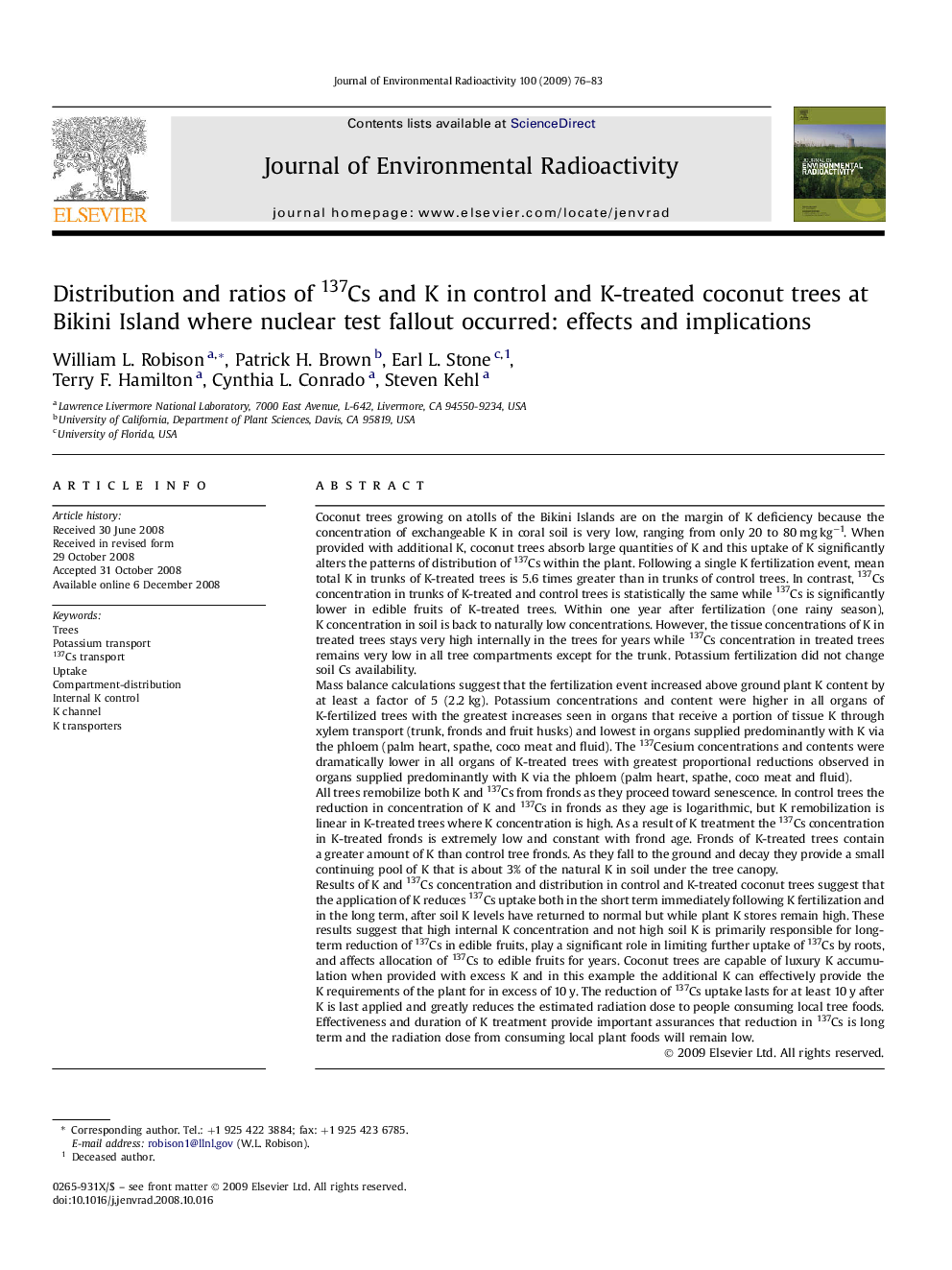| کد مقاله | کد نشریه | سال انتشار | مقاله انگلیسی | نسخه تمام متن |
|---|---|---|---|---|
| 1739062 | 1016830 | 2009 | 8 صفحه PDF | دانلود رایگان |

Coconut trees growing on atolls of the Bikini Islands are on the margin of K deficiency because the concentration of exchangeable K in coral soil is very low, ranging from only 20 to 80 mg kg−1. When provided with additional K, coconut trees absorb large quantities of K and this uptake of K significantly alters the patterns of distribution of 137Cs within the plant. Following a single K fertilization event, mean total K in trunks of K-treated trees is 5.6 times greater than in trunks of control trees. In contrast, 137Cs concentration in trunks of K-treated and control trees is statistically the same while 137Cs is significantly lower in edible fruits of K-treated trees. Within one year after fertilization (one rainy season), K concentration in soil is back to naturally low concentrations. However, the tissue concentrations of K in treated trees stays very high internally in the trees for years while 137Cs concentration in treated trees remains very low in all tree compartments except for the trunk. Potassium fertilization did not change soil Cs availability.Mass balance calculations suggest that the fertilization event increased above ground plant K content by at least a factor of 5 (2.2 kg). Potassium concentrations and content were higher in all organs of K-fertilized trees with the greatest increases seen in organs that receive a portion of tissue K through xylem transport (trunk, fronds and fruit husks) and lowest in organs supplied predominantly with K via the phloem (palm heart, spathe, coco meat and fluid). The 137Cesium concentrations and contents were dramatically lower in all organs of K-treated trees with greatest proportional reductions observed in organs supplied predominantly with K via the phloem (palm heart, spathe, coco meat and fluid).All trees remobilize both K and 137Cs from fronds as they proceed toward senescence. In control trees the reduction in concentration of K and 137Cs in fronds as they age is logarithmic, but K remobilization is linear in K-treated trees where K concentration is high. As a result of K treatment the 137Cs concentration in K-treated fronds is extremely low and constant with frond age. Fronds of K-treated trees contain a greater amount of K than control tree fronds. As they fall to the ground and decay they provide a small continuing pool of K that is about 3% of the natural K in soil under the tree canopy.Results of K and 137Cs concentration and distribution in control and K-treated coconut trees suggest that the application of K reduces 137Cs uptake both in the short term immediately following K fertilization and in the long term, after soil K levels have returned to normal but while plant K stores remain high. These results suggest that high internal K concentration and not high soil K is primarily responsible for long-term reduction of 137Cs in edible fruits, play a significant role in limiting further uptake of 137Cs by roots, and affects allocation of 137Cs to edible fruits for years. Coconut trees are capable of luxury K accumulation when provided with excess K and in this example the additional K can effectively provide the K requirements of the plant for in excess of 10 y. The reduction of 137Cs uptake lasts for at least 10 y after K is last applied and greatly reduces the estimated radiation dose to people consuming local tree foods. Effectiveness and duration of K treatment provide important assurances that reduction in 137Cs is long term and the radiation dose from consuming local plant foods will remain low.
Journal: Journal of Environmental Radioactivity - Volume 100, Issue 1, January 2009, Pages 76–83